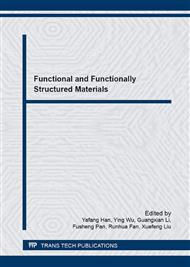[1]
B. E. Conway, Transition from supercapacitor" to "battery, behavior in electrochemical energy storage, Journal of the Electrochemical Society. 138(1991) 1539-1548.
DOI: 10.1149/1.2085829
Google Scholar
[2]
B. E. Conway, Electrochemical supercapacitor, Scientific Fundamentals and Technological Applications, Kluwer Academic/Plenum Publishers, New York, (1999).
Google Scholar
[3]
A. Burke. Ultracapacitors: why, how, and where is the technology, Journal of power sources. 91(2000) 37-50.
DOI: 10.1016/s0378-7753(00)00485-7
Google Scholar
[4]
H. K. Jeong, M Jin, E J Ra, et al. Enhanced electric double layer capacitance of graphite oxide intercalated by poly (sodium 4-styrensulfonate) with high cycle stability, Acs Nano. 4(2010) 1162-1166.
DOI: 10.1021/nn901790f
Google Scholar
[5]
T. E. Rufford, D. Hulicova-Jurcakova, Z. Zhu, et al, Empirical analysis of the contributions of mesopores and micropores to the double-layer capacitance of carbons, The Journal of Physical Chemistry C, 113(2009) 19335-19343.
DOI: 10.1021/jp905975q
Google Scholar
[6]
K. C. Liu, M. A. Anderson. Porous nickel oxide/nickel films for electrochemical capacitors, Journal of the Electrochemical Society. 143(1996) 124-130.
DOI: 10.1149/1.1836396
Google Scholar
[7]
V. Srinivasan, J. W. Weidner, An electrochemical route for making porous nickel oxide electrochemical capacitors, Journal of the Electrochemical Society. 144(1997) L210-L213.
DOI: 10.1149/1.1837859
Google Scholar
[8]
V. Srinivasan, J. W. Weidner. Studies on the capacitance of nickel oxide films: effect of heating temperature and electrolyte concentration, Journal of the Electrochemical Society. 147-3(2000) 880-885.
DOI: 10.1149/1.1393286
Google Scholar
[9]
K. W. Nam, K. B. Kim, A study of the preparation of NiO x electrode via electrochemical route for supercapacitor applications and their charge storage mechanism, Journal of the Electrochemical Society, 149-3(2002) A346-A354.
DOI: 10.1149/1.1449951
Google Scholar
[10]
K. W. Nam, W. S. Yoon, K. B. Kim, X-ray absorption spectroscopy studies of nickel oxide thin film electrodes for supercapacitors, Electrochimica Acta, 47(2002) 3201-3209.
DOI: 10.1016/s0013-4686(02)00240-2
Google Scholar
[11]
E. E. Kalu, T. T. Nwoga, V. Srinivasan, et al. Cyclic voltammetric studies of the effects of time and temperature on the capacitance of electrochemically deposited nickel hydroxide, Journal of power sources. 92(2001) 163-167.
DOI: 10.1016/s0378-7753(00)00520-6
Google Scholar
[12]
T. Zhu, J. S. Chen, Lou X W. Shape-controlled synthesis of porous Co3O4 nanostructures for application in supercapacitors, Journal of Materials Chemistry. 20(2010) 7015-7020.
DOI: 10.1039/c0jm00867b
Google Scholar
[13]
H. S. Nam, J. S. Kwon, K. M. Kim, et al. Super-capacitive properties of a nanowire-structured MnO2 electrode in the gel electrolyte containing silica, Electrochimica Acta. 55(2010) 7443-7446.
DOI: 10.1016/j.electacta.2010.02.027
Google Scholar
[14]
J. Yan, E. Khoo, A. Sumboja, et al. Facile coating of manganese oxide on tin oxide nanowires with high-performance capacitive behavior, Acs Nano. 4(2010) 4247-4255.
DOI: 10.1021/nn100592d
Google Scholar
[15]
X. Du, C. Wang, M. Chen, et al, Electrochemical performances of nanoparticle Fe3O4/activated carbon supercapacitor using KOH electrolyte solution, The Journal of Physical Chemistry C, 113(2009) 2643-2646.
DOI: 10.1021/jp8088269
Google Scholar
[16]
M. S. Wu, H. H. Hsieh. Nickel oxide/hydroxide nanoplatelets synthesized by chemical precipitation for electrochemical capacitors, Electrochimica Acta. 53(2008) 3427-3435.
DOI: 10.1016/j.electacta.2007.12.005
Google Scholar


